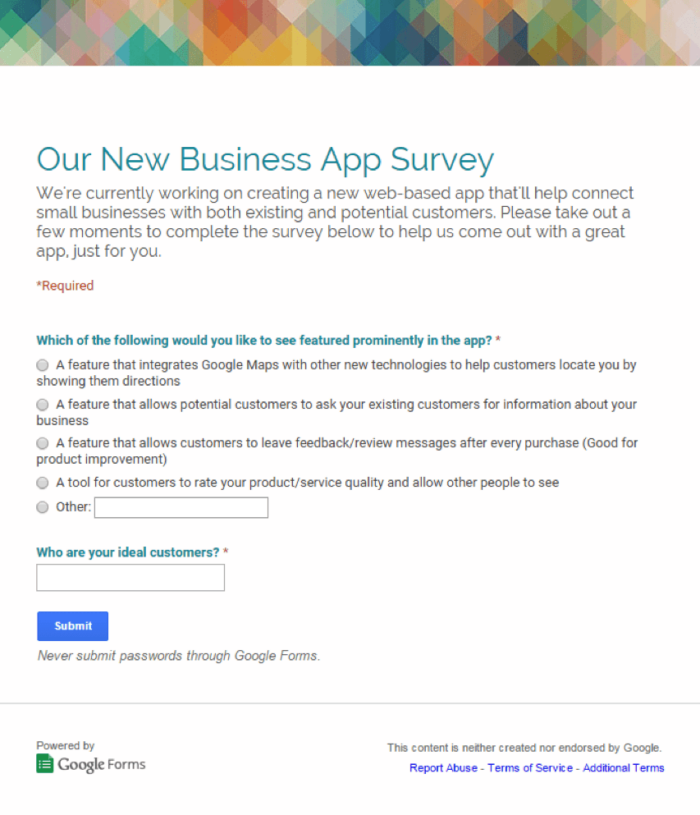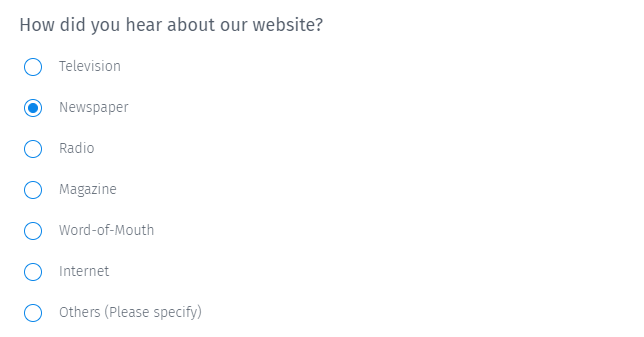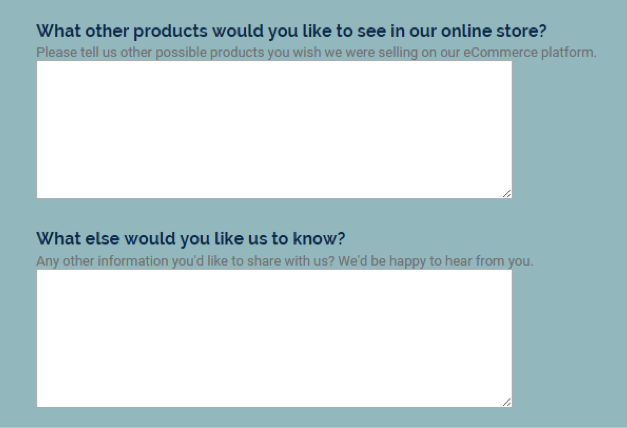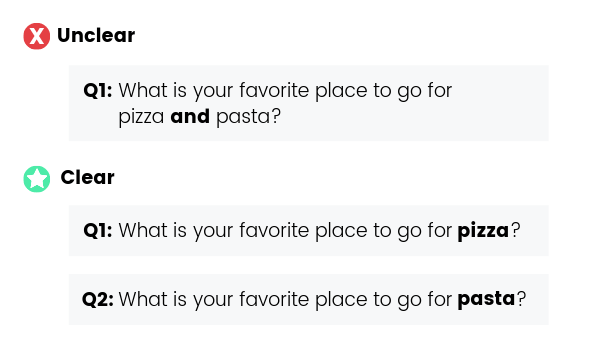
Are you wasting time and money because you don’t really know your customers? Creating products that your customers don’t want just doesn’t make sense. In any business, before you can meet your customers’ needs, you have to know:
- What are their problems?
- What solutions do they want?
- How can you introduce those solutions to them?
So, do you know your customers’ needs? If not, now is the time to analyze who your customers are and how you can give them what they want, before they seek answers elsewhere.
Luckily, doing this is easier than you may think. You can gain practically everything you need to make your customers happy by using survey questions for market research.
While there are several ways to gather customer information, customer surveys work and are one of the most effective methods to use when collecting this kind of data.
Surveys are great information-gathering tools, but to get accurate results, you have to ask the right questions in the right way.
We’ll look at the kinds of questions to ask. These questions will unlock your customers’ innermost thoughts, get you the answers you want, and even help you segment your customer base.
First, here are some general guidelines to help you prepare result-focused survey questions for market research:
1. Remember KISS (Keep It Simple, Stupid)
When it comes to surveying, simplicity is key.
Most people are pretty busy, so they don’t have time to answer overly complex, lengthy surveys.
This is why you have to make the questions easy to comprehend. Additionally, verify that your market research survey questions are easy to access and answer.
Brevity is important. A lengthy survey likely means high abandonment rates. High abandonment rates mean you may not get the best results because they create:
- A poor survey experience.
- Responses with incomplete information.
- Less representative final data.
You want people to respond excitedly to your questions, right? A 40-minute survey won’t support that.
The bottom line here is to remember the KISS principle and apply it.
Here’s a great example screenshot of a short survey:

Instead of using a detailed questionnaire, go with plain, easy-to-understand survey templates, and rather than asking complex questions, ask simple questions with a well-defined approach.
Asking complicated questions may confuse or even frustrate respondents. When that happens, two things are bound to follow: they will either not answer the question at all, or, if they do, they will give you unclear, inaccurate answers.
By complicated questions, I mean:
- Trick questions: These are purposefully deceptive and complex so respondents often answer in a specific way.
- Long questions: These are long, convoluted questions that provide so much information that it becomes difficult to comprehend and answer accurately.
- Confusing questions: These are simply questions that don’t make sense to the respondent.
Avoid these at all costs to engage participants and obtain accurate results.
When writing survey questions for market research, the main goal is to keep things as direct as possible.
Do you know the variations of the phrase KISS? “Keep It Simple and Straightforward” and “Keep It Short and Simple” also apply here.
To get respondents to answer your questions, keep it simple, short, and straightforward.
2. Avoid Too Many Polar “Yes/No” Questions
Polar questions have only two possible answers: yes (confirmatory) and no (negative). They’re also known as yes/no questions.
Why should you avoid asking only polar questions?
Well, the simple reason is that when you ask a yes/no question, that’s all you will get. Respondents don’t have the chance to tell you what’s on their minds (which may be other possible answers that you hadn’t considered).
Closed-ended questions may lead respondents toward a particular answer which can easily create bias. This won’t unlock your respondents’ authentic answers.
Survey questions that pull respondents toward one answer can disrupt the objective of the survey. When using questions in a survey, make sure the options for responses are as unbiased as possible.
An alternative to yes/no questions is multiple-choice questions. You can ask survey participants to select one answer or “all that apply.”
Here is an example of a polar question:

Here is an example of a multiple-choice question:

Just keep in mind that multiple-choice questions may not always provide the best information, as they are still somewhat closed-ended.
However, multiple-choice questions do give respondents the chance to choose from various choices, and you may find that their preferred choice is different from what you anticipated.
To get additional information, you can always provide a space for unique answers and call it “Others – please specify” or something similar.
When asking a multiple-choice question, remember to include all the possible answers you can think of that respondents may want to choose.
You should consider using polar or multiple-choice questions in a survey when you want to:
- Offer a set number of responses to choose from.
- Collect unambiguous answers.
- Receive simple responses to simple questions.
- Create a short, quick survey that takes respondents less time.
Polar and multiple-choice questions make it easy to capture and analyze data. In other words, you’ll be able to generate more quantitative data that gives clear-cut numerical results. You’ll know exactly what respondents answer with because you’re the one that wrote the responses.
What’s more, you can give customers some freedom by asking one or two open-ended questions after polar or multiple-choice questions to gain more clarity. This leads us to my next point.
3. Write a Couple of Smart Open-Ended Questions
Open-ended questions are a type of survey question for market research requiring the respondent to write a comment, an essay, or other types of free-reaction text. They produce qualitative data, which is a little more difficult to analyze at the end of the survey than quantitative (numerical) data. These responses will give you a lot of juicy details, though, so it’s well worth the effort.
You don’t need to make all the questions open-ended, but you should aim to include at least one or two. This will free your respondents to blurt out what’s on their minds without holding back.
Below are two thoughtful, open-ended questions culled from a recent survey by an e-commerce company:

When asking an open-ended question, you need to be careful, as some respondents may get carried away and provide you with long blocks of text.
To prevent this, provide a text box where they can write their answers, but limit the number of characters the text box can accept. That way, they’ll provide you with only the most important things they have to say.
4. Ask One Question at a Time
How do you feel when someone asks you a string of questions?
“How did you find our products? What results have you gotten by using our products? Which of our products do you find most beneficial and why?”
You probably feel like the desperate interrogator wouldn’t let you finish your sentence. That’s exactly how your respondents feel when you ask a chain of questions at once.
In addition, multiple questions make it hard for people to give precise responses, making it difficult for you to interpret those answers.

One approach to solving this issue is to aim for questions that encompass multiple things you want to ask. However, avoid this if the question becomes too long or confusing. Otherwise, providing space to respond between each question is likely your best bet.
3 Example Survey Questions That Will Help You Know (and Solve) Your Customers’ Biggest Problems
Next, we will be looking at some specific survey questions for market research that can get you helpful answers.
These investigative questions will help you discover your audience’s biggest problems. They’ll also help you know what product to create and what to share with your customers in your newsletters, walk-through guides, blogs, etc.
The truth is, as a business, your job is to solve problems and meet people’s needs. This could be by rendering a service, creating a product, or sharing helpful information and fresh content, just as we do here at the Neil Patel blog.
You cannot solve any problem without getting to know it first; thus, asking these questions is critical.
With that in mind, here are some pin-pointing, open-ended survey questions for market research that will elicit helpful answers from your audience:
1. What’s Your Biggest Challenge in ___?
Are there challenging situations that customers are facing right now in your specialization? Your customers are the best people to give you this insight.
The answers to this question will help you understand the greatest problem your customers need help with so that you know where to focus your company’s energy.
Sometimes, you may receive diverse answers from respondents; however, with the data gathered, you will find the most significant common challenge among them.
2. What Are Your Most Burning Questions About____?
You’ve been doing all the interrogations so far. Now, it’s time for customers to take their turn. Sometimes the most useful information you’ll gather comes from customers’ questions rather than their answers.
The trick is to get them to ask only their most burning questions about the niche or subject you’re dealing with.
So, that means you might have to limit the number of characters in the text box or just tell customers to ask only their most important questions.
By the way, if you do share information with your audience (through blogs, videos, podcasts, newsletters, eBooks, eCourses, etc.), the questions your customers ask here will help provide you with a bunch of content ideas you can use for a long time.
Their questions may even generate ideas for services to add to your service list, products to create, and other ways to improve your existing offerings.
But, if you want to lay it on the line, you can really tap into their wits. That’s the job of the next question.
3. What’s Not Out There? What Product, Service, Tool, or App Would You Like to See?

If you use only your own ideas for products without customer feedback, you may end up creating the wrong product. This is a product that won’t sell a piece, won’t make you a dime, and won’t solve a single problem.
Luckily, customers can help you avoid this dilemma. You can be explicit by asking this question to define what people want and need.
Surveys can make or break your start-up because they are all about how well you comprehend what your customers want to tell you. Not using them can mean taking a shot in the dark about whether a product will succeed. A product misfire can sink a company in its early stages. Even at the enterprise level, a product that doesn’t meet company needs can have severe consequences.
The answers you get here will help position you advantageously to create products that matter, thereby giving you an edge over your competitors.
2 Example Survey Questions That Will Help You Know How to Best Reach Your Audience
While the questions above will get you helpful customer-centric answers, it’s not all about knowing what your customers want. You also have to find out who they really are and how to reach them.
Here are some questions to help you do that:
1. What Level of Expertise (Beginner, Intermediate, or Expert) Do You Have in ___?
You may think you know who your audience is, but do you really? Without a basic knowledge of who you’re reaching out to, you may not be able to solve their problems.
This question is especially significant if you are responsible for training people (through in-app messages, blogging, video content, webinars, online courses, information products, etc.).
Knowing your customers’ level of expertise will help you comprehend how much support they need and what sort of content you should create for them. Also, you can easily determine which features a product needs based on customer experience and knowledge. Customers with less expertise may need features that those with more expertise don’t want.
All this information improves the customer experience and helps you better serve your target audience.
2. What’s Your Preferred Method of Learning (Reading, Listening, Watching, Practicing, or Other)?
Even if you create the best podcast that’s ever existed, it won’t matter if your customers prefer to receive information via written online content like blogs. You have to know how to reach your customers where they are.
This question is important for narrowing down where your audience exists, but it also helps you gain insight into alternative possibilities. Perhaps you’ve been focusing on helping your audience learn by listening when they really want to learn by watching.
Use the responses to this question to analyze where you’re meeting your audience’s preferences and where you may be falling short.
How to Build Survey Questions for Your Audience
So far, you know that survey questions should be:
- Simple.
- Honest.
- Understandable.
- Unbiased.
You also know that a healthy mixture of closed-ended and open-ended questions will give you the most accurate results. Also, it’s not a good idea to ask too many questions in a row before allowing respondents to answer because it can make the survey a little overwhelming.
With all this in mind, you are ready to build out your survey questions for market research.

The first thing to consider is what you want to gather from your survey results. What do you want to know, and how will this help you give your customers what they need?
Survey language is critical here because you want respondents to recognize what you’re asking so that they can give you the most accurate answers.
Second, think about your audience. What sort of experience do you want them to have while taking the survey? Respondents who can effortlessly complete a survey will likely give you better responses with more meaningful insights.
In addition to others mentioned in this blog, some survey design mistakes to avoid include:
- Poor mobile optimization.
- Too many personal or sensitive questions.
- Repetitive questions.
- Survey fatigue.
The third factor to focus on is the format. If respondents have trouble navigating the survey or selecting their answers, this will lead to a bad experience and poor survey results.
Frequently Asked Questions
How long should my survey be?
When crafting survey questions for market research, aim for less than 30 questions. The survey should take participants about 10 minutes or less to finish to avoid bad-quality answers or abandonment.
Where can I build an online survey?
Figuring out how to design survey questions for market research is so much easier when you use online resources and tools. For example, QuestionPro makes it simple to build, design, and distribute surveys to all of your participants.
What is a good sample size for a survey?
Statisticians agree that a good sample size should land around 100 participants or more if you want significant results. Nevertheless, aim for about 10% of the target population (or 1,000 participants max) to get the most accurate findings.
What types of questions should I ask on my survey?
You’ll need to use various question types to engage respondents and make the survey easier to complete. Ask a blend of yes/no, multiple-choice, and open-ended questions for the best survey outcomes.
Conclusion
A great product and excellent customer service begin with getting to know who your customers are and what they want. For this to happen, you have to compile customer information, and surveys are one of the best methods to collect precisely what you need.
When reaching out to gather customer information, it’s essential to get it right from the beginning. The types of questions you ask play an important role in creating a successful survey.
You won’t get good responses when you ask bad questions. Pay attention to how you’re framing questions and what possible answers respondents may give to gain the highest-quality results from your survey.
If you take the time to write good survey questions for market research, you’ll be on your way to getting handy customer information that can help you drive your business in the right direction.
The next time you conduct a survey, try the tips above, ask the right questions just as I’ve pointed out, and you’ll be on your way to uncovering your customers’ deepest desires.
Do you use market research surveys? If so, what type of questions do you usually ask? Let me know below!
from Neil Patel https://ift.tt/wydWIGH
via IFTTT
No comments:
Post a Comment